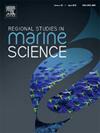Temporal variations in water quality in a tropical urbanized estuary
IF 2.1
4区 环境科学与生态学
Q3 ECOLOGY
引用次数: 0
Abstract
Seasonal variability in water quality plays a crucial role in understanding the resilience and impacts on culturally eutrophic estuarine environments, such as Guanabara Bay (Brazil). We evaluated potential seasonal influences on a culturally eutrophic estuarine environment during 2011 and 2012 by assessing water quality variables at six sites visited monthly. Despite persistent sewage discharges and elevated nutrient levels, we hypothesize a hydrobiological response to climatic variations. All data were compiled into a database and analyzed using descriptive statistics. Principal Component Analysis (PCA) was employed to integrate chemical and biological data, providing insights into general ecological patterns within Guanabara Bay. Time series analyses were performed using adjusted models to examine the nature and structure of the data, prioritizing pattern evaluation over forecasting scenarios. Significant seasonal variations were observed for nitrogenous compounds (ammonia and nitrite), temperature, and dissolved oxygen. During the dry season (May to September), ammonia and nitrite concentrations were high, while temperature and dissolved oxygen were low. The opposite pattern was observed during the rainy season (October to April). Rainfall and river drainage, which carry domestic and industrial sewage from the bay’s watershed, strongly influenced surface waters. In contrast, bottom waters appeared unaffected by seasonal influences, instead responding to tidal currents. Despite severe negative environmental impacts, significant trends were obtained even with just two years of data. These findings indicate that annual climatic cycles mainly drive seasonal patterns in Guanabara Bay’s water quality.
求助全文
约1分钟内获得全文
求助全文
来源期刊

Regional Studies in Marine Science
Agricultural and Biological Sciences-Ecology, Evolution, Behavior and Systematics
CiteScore
3.90
自引率
4.80%
发文量
336
审稿时长
69 days
期刊介绍:
REGIONAL STUDIES IN MARINE SCIENCE will publish scientifically sound papers on regional aspects of maritime and marine resources in estuaries, coastal zones, continental shelf, the seas and oceans.
 求助内容:
求助内容: 应助结果提醒方式:
应助结果提醒方式:


